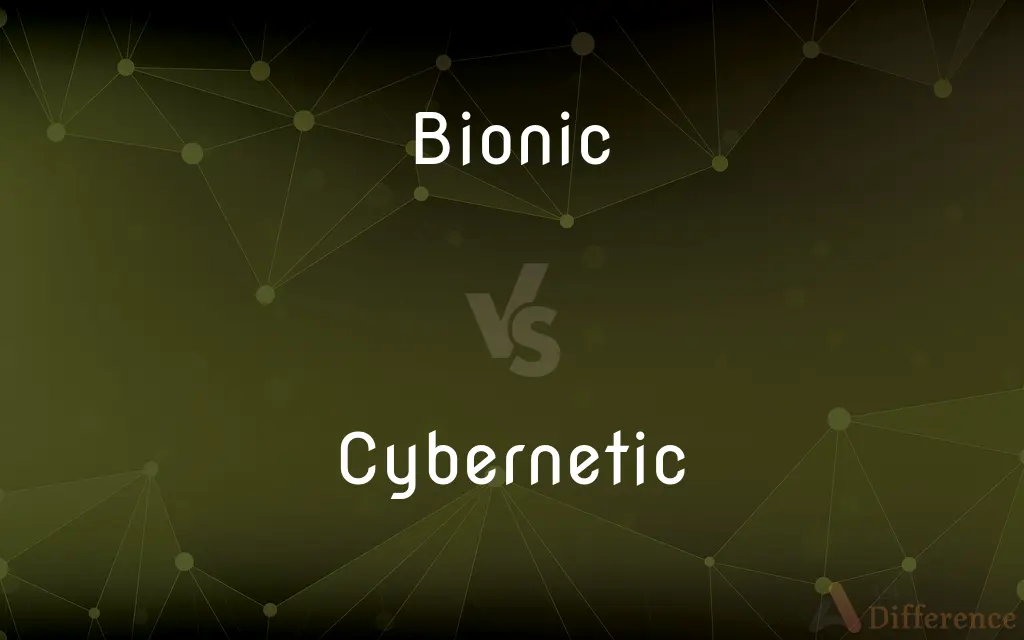Bionic vs. Cybernetic — What's the Difference?
By Tayyaba Rehman — Updated on October 27, 2023
Bionic refers to artificial body parts enhancing human capabilities, while cybernetic involves systems of control and communication in machines and living beings.

Difference Between Bionic and Cybernetic
Table of Contents
ADVERTISEMENT
Key Differences
Bionic technology focuses on artificial body parts or systems that enhance or replace natural biological capabilities. It often pertains to prosthetics or implants designed to improve human performance. In contrast, cybernetics studies systems of control and communication in both machines and living organisms, emphasizing the relationship between technology and biology.
Bionics has applications in medical fields, providing advanced prosthetic limbs, artificial organs, and sensory aids. These devices are engineered to mimic or surpass natural functions. Cybernetics, on the other hand, encompasses broader applications, including robotics, artificial intelligence, and systems theory, focusing on feedback, control mechanisms, and communication processes.
Innovation in bionic technology aims at seamless integration with the human body, enhancing physical abilities or restoring lost functions. Cybernetic research delves into understanding complex systems, including biological networks, to improve interactions and efficiencies between humans and machines.
Bionics often finds its use in rehabilitative medicine and human augmentation, while cybernetics can be applied in various fields, from computer science to ecology, exploring how systems regulate themselves and interact with their environment.
While both fields intersect in some areas, bionics is primarily concerned with human enhancement, and cybernetics deals with broader system interactions and control mechanisms.
ADVERTISEMENT
Comparison Chart
Focus Area
Artificial body parts and systems.
Control and communication systems.
Primary Application
Medical field, human enhancement.
Robotics, AI, systems theory.
Aim
Enhance or replace biological capabilities.
Understand and improve system interactions.
Integration
Integration with the human body.
Interaction between humans, machines, and environments.
Key Aspects
Prosthetics, artificial organs.
Feedback, control mechanisms, communication processes.
Compare with Definitions
Bionic
Enhances human biological capabilities.
The bionic arm restored his mobility.
Cybernetic
Studies control and communication in systems.
Cybernetic principles improved the robot's efficiency.
Bionic
Engineered to mimic natural functions.
Her bionic hand had a remarkably natural grip.
Cybernetic
Focuses on feedback loops and control.
The cybernetic system self-regulated its temperature.
Bionic
Used in rehabilitative medicine.
Bionic implants improved her hearing significantly.
Cybernetic
Aids in understanding complex systems.
Cybernetic models helped predict ecological changes.
Bionic
Includes advanced prosthetics and implants.
The bionic eye provided him with vision.
Cybernetic
Applied in robotics, AI, and more.
Cybernetic algorithms enhanced the software's capabilities.
Bionic
Of or relating to bionics.
Cybernetic
Examines human and machine interactions.
Cybernetic research led to better user interfaces.
Bionic
Having anatomical structures or physiological processes that are replaced or enhanced by electronic or mechanical components.
Cybernetic
The theoretical study of communication and control processes in biological, mechanical, and electronic systems, especially the comparison of these processes in biological and artificial systems.
Bionic
Having extraordinary strength, powers, or capabilities; superhuman.
Cybernetic
Of or relating to cybernetics—the mathematical study of communication and control in living organisms or machines.
Bionic
(not comparable) Related to bionics.
Cybernetic
Of or relating to computers and internet.
Bionic
(of a biological organism) Having been enhanced by electronic or mechanical parts; cyborg.
Cybernetic
Of or relating the principles of cybernetics;
Cybernetic research
Bionic
Superhuman.
Bionic
Of or relating to bionics
Bionic
Having particular physiological functions augmented or replaced by electronic or electromechanical components
Bionic
Aims to augment human abilities.
Bionic legs enabled him to run faster.
Common Curiosities
Is bionic technology used only for limbs?
No, it includes various prosthetics and implants, not just limbs.
Are bionic limbs common?
Yes, bionic limbs are increasingly common in medical prosthetics.
What is the main focus of bionic technology?
It focuses on artificial body parts enhancing human capabilities.
Can cybernetics be applied to ecology?
Yes, cybernetics can be applied to understand ecological systems.
What does cybernetic study entail?
It studies systems of control and communication in machines and living beings.
Are cybernetic principles used in robotics?
Absolutely, cybernetics is fundamental in robotics.
Does cybernetic involve only machines?
No, it also concerns living organisms and their interactions.
Can cybernetics help in system efficiency?
Yes, it helps in improving system interactions and efficiencies.
How do cybernetic systems manage feedback?
They use feedback loops to self-regulate and adapt.
Does cybernetic involve artificial intelligence?
Yes, cybernetics is significant in developing AI systems.
Can bionics provide superhuman abilities?
In some cases, bionics can enhance abilities beyond normal human levels.
Is bionic technology customizable?
Yes, bionic devices can be customized for individual needs.
Can bionics help restore lost senses?
Yes, bionics can help restore senses like hearing or sight.
Are bionic advancements rapid?
Yes, there are rapid advancements in bionic technology.
Is bionic technology widely accessible?
Accessibility is improving, but there are still challenges.
Share Your Discovery

Previous Comparison
Beneath vs. Under
Next Comparison
Jehovah vs. YahwehAuthor Spotlight
Written by
Tayyaba RehmanTayyaba Rehman is a distinguished writer, currently serving as a primary contributor to askdifference.com. As a researcher in semantics and etymology, Tayyaba's passion for the complexity of languages and their distinctions has found a perfect home on the platform. Tayyaba delves into the intricacies of language, distinguishing between commonly confused words and phrases, thereby providing clarity for readers worldwide.














































